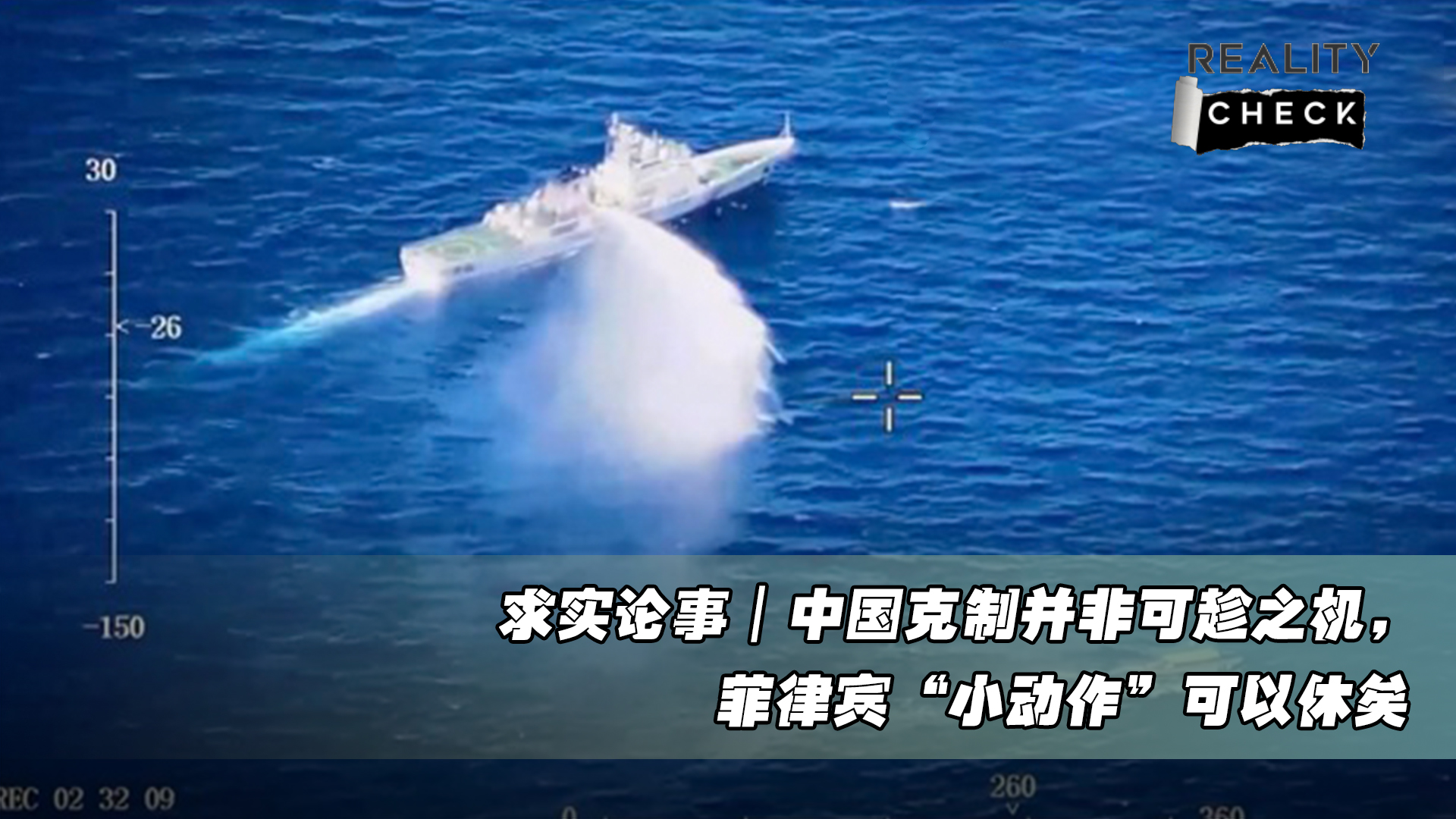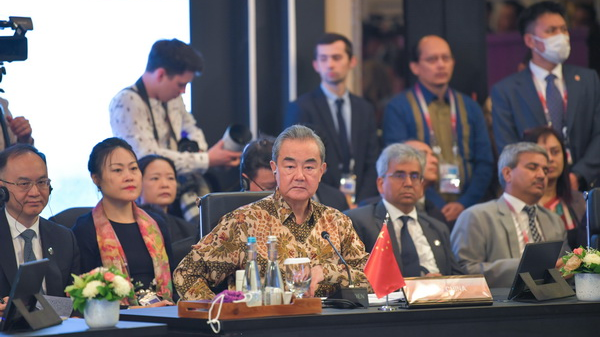02:08

When the China Coast Guard blocked and fired water cannons at two Philippine vessels on Saturday to stop them from sending construction materials to a rumbling boat that was grounded at Ren'ai Jiao in the South China Sea, many may wonder what's behind the clash and why a rusty old Philippine warship is involved.
At first glimpse, it looks like a dilapidated ghost ship in the turquoise waters, but this former U.S. Navy warship is actually maintained by a contingent of Philippine Marines and sailors, and was deliberately grounded at Ren'ai Jiao in 1999 to make it service as a permanent Philippine government installation.
The recent conflict over the rumbling boat is another flare-up of territorial issues between Manila and Beijing over the waters in the South China Sea. Since 2011, the Philippines has been consolidating the deteriorating shipwreck and in 2014, the country brought up a so-called arbitration against China over the South China Sea islands sovereign issues.
And in recent years, due to increasing geopolitical strife and the step-in of the U.S. and other Western countries, the regional matter of the South China Sea is becoming even more complicated.
Beyond the Ren'ai Jiao conflict, what's China's stance on the South China Sea issue and will China's position affect the increasingly amicable relations between China and the Association of Southeast Asian Nations (ASEAN)?
China promotes DOC and COC to solve the South China Sea issue
China has long been advocating to solve the South China Sea issue through dialogue and consultations between countries directly concerned and opposing countries outside of the region to interfere.
While attending the 13th East Asia Summit Foreign Ministers' Meeting in the Indonesian capital Jakarta last month, senior Chinese diplomat Wang Yi mentioned the Declaration on the Conduct of Parties in the South China Sea (DOC), saying it stipulated bilateral negotiations as the means of resolving border and other disputes, and played a vital role in maintaining peace in the South China Sea and enhancing mutual trust between China and ASEAN countries.
The DOC is the first political document on the South China Sea issue signed by China and the members of ASEAN in Phnom Penh in 2002 to avoid conflicts in the waters. It reaffirms freedom of navigation and overflight, peaceful settlement of disputes, and self-restraint in the conduct of activities. While, the initial intention of China and ASEAN was to formulate the Code of Conduct (COC) for the South China Sea, a more specific version of the declaration.
Both the DOC and COC are not aiming to resolve territorial claims and disputes. Instead, they seek to prevent military incidents and manage conflict in the disputed area. In addition, the COC is envisaged to set out regional cooperation initiatives such as resource management, fishing, marine scientific research, and environmental protection.
Over the years, all parties concerned have made it clear that their ultimate goal is to reach the COC and much progress has been achieved.
As of March this year, China and ASEAN countries have carried out 38 rounds of consultations over the COC draft, and the second reading of the COC negotiating text (the first reading was completed in July 2019) was completed this July, according to the Chinese Foreign Ministry. They have also agreed at the Jakarta meeting to increase the frequency of meetings of the China-ASEAN Joint Working Group, which is tasked with drawing up the COC, to four or more a year, and announced an aspirational goal of three years to complete the talks.
"Promoting the COC consultation serves the shared interests of China and ASEAN countries, and is a crucial step to ensure that the South China Sea becomes a sea of peace and cooperation," said Wang, director of the Office of the Foreign Affairs Commission of the Communist Party of China (CPC) Central Committee, adding China is "fully confident" in the conclusion of the COC.

Wang Yi, director of the Office of the Foreign Affairs Commission of the CPC Central Committee, attends the 13th East Asia Summit Foreign Ministers' Meeting in Jakarta, Indonesia, July 14, 2023. /Xinhua
Wang Yi, director of the Office of the Foreign Affairs Commission of the CPC Central Committee, attends the 13th East Asia Summit Foreign Ministers' Meeting in Jakarta, Indonesia, July 14, 2023. /Xinhua
External forces complicate the South China Sea issue
China has been an important partner of ASEAN in the Indo-Pacific region for over three decades. Their economic cooperation has been greatly strengthened and both sides have decided to further promote regional economic integration in recent years.
Official data shows that the trade volume between China and ASEAN, which are each other's largest trading partners, is expected to exceed $1 trillion this year. China is the fourth-largest source of foreign direct investment in ASEAN, with a value of $13.8 billion in 2021. And negotiations for the Free Trade Agreement (FTA) 3.0 and the implementation of the Regional Comprehensive Economic Partnership (RCEP) between the two sides are also accelerating.
Experts say though China and ASEAN have formed a relationship that is centered on economic and trade cooperation, and based on regional order and mutual respect for each other's core interests, there remain challenges due to increasing geopolitical concerns and external interference, especially from the United States.
Wu Shicun, president of the National Institute for South China Sea Studies, analyzed in a recent journal that the U.S. regards the South China Sea issue as an important tool to contain China and consolidate its hegemony, and that the Biden administration is sparing no effort to draw other countries in to form an "Indo-Pacific version of NATO" and sow discord between China and relevant claimant states.
According to Wu, the number of bilateral and multilateral joint military exercises conducted by the U.S. military in the South China Sea and its surrounding waters has increased from 19 in 2016 to 48 in 2022. He said that these moves by the U.S. has made ASEAN countries get caught between China and the U.S. and undermined South China Sea stability.
The Chinese Foreign Ministry on many occasions has advocated the proposal of "setting aside dispute and pursuing joint development" (it was first formally proposed in 1979 by Deng Xiaoping to resolve the Diaoyu Island issue) to peacefully resolve territorial disputes in the South China Sea and promote cooperation and common development. It also called on ASEAN countries to focus on cooperation and exclude external interference.
"I hope that ASEAN countries can stay clear-eyed about this and jointly resist the disturbances and sabotage from outside," Wang said in July, expressing confidence that no external disturbances can stand in the way of regional cooperation.
(Cover image: A screenshot from the video released by the China Coast Guard shows a China Coast Guard ship firing water cannons at a Philippine vessel, August 5, 2023. /China Coast Guard)